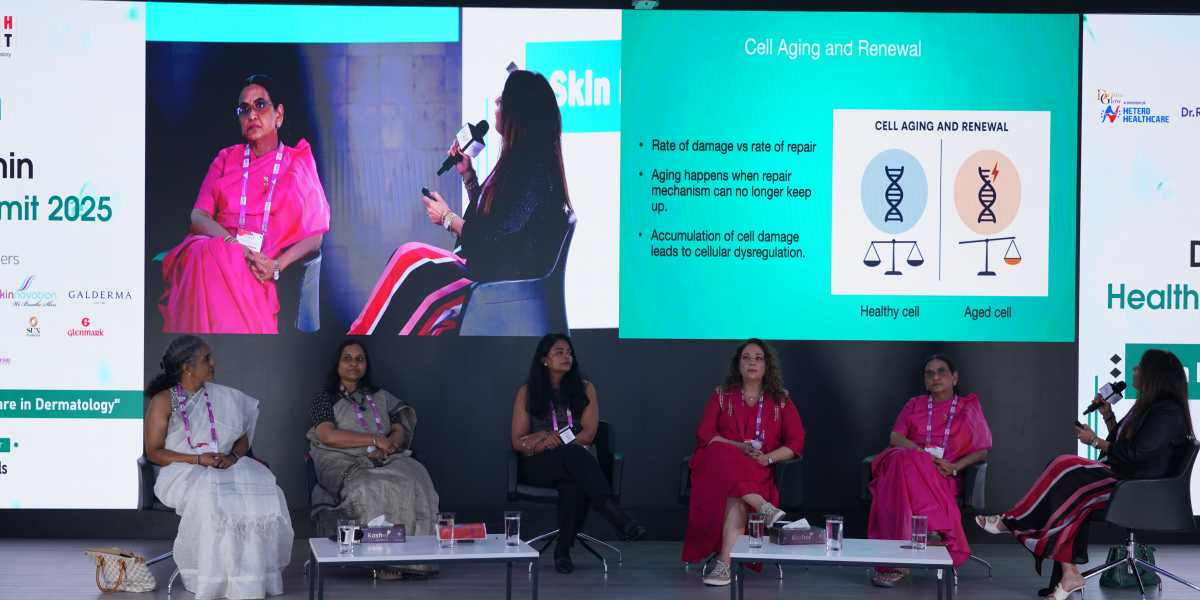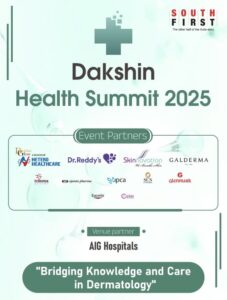Dr Maya Vedamurthy, senior dermatologist and director of RSV Skin Clinic, Chennai, laid the foundation by explaining ageing mechanisms.
Published Nov 12, 2025 | 7:25 PM ⚊ Updated Nov 12, 2025 | 7:25 PM

Skin Health and Aging Panel _at the Dakshin Health Summit 2025. (South First)
Synopsis: At the second edition of the Dakshin Health Summit, dermatologists championed “skin cycling”—a 3-4 day routine of exfoliation, retinol/bakuchiol, and repair with ceramides/peptides—to combat intrinsic and extrinsic ageing. Retinol remains the “gold standard”, alongside 10% niacinamide, sunscreen, and microbiome-supporting probiotics. Experts urged starting anti-ageing in the 20s, personalised routines, and regular derm visits for lasting results beyond hype.
In an era of endless skincare products promising youthful skin in a bottle, dermatologists at the second edition of South First’s Dakshin Health Summit have outlined a scientific approach to topical anti-ageing, introducing the concept of “skin cycling” and revealing which ingredients truly deliver results beyond marketing hype.

The second edition of the Dakshin Health Summit 2025 was held at the Asian Institute of Gastroenterology in Hyderabad on Sunday, 9 November.
At the panel discussion on ‘Skin Health & Ageing’ held at the Asian Institute of Gastroenterology (AIG), Gachibowli, on Sunday, 9 November, experts distinguished between products that work and those that simply drain wallets, whilst emphasising that proper usage matters as much as ingredient selection.
Dr Malavika Kohli, senior dermatologist and director of Skin Secrets, Mumbai, who moderated the discussion, framed the conversation around what she called “longevity in a bottle.”
“There are two types of bottles: the ones people take (pills, capsules, powders) and the ones people apply (lotions and potions). I’m talking about the lotions and potions.”
Dr Maya Vedamurthy, senior dermatologist and director of RSV Skin Clinic, Chennai, laid the foundation by explaining ageing mechanisms.
“There are two types of ageing: Intrinsic ageing and extrinsic ageing. In extrinsic ageing, we always talk about photo-ageing, but we forget about the exposomes—pollution, smoking, sleep, diet—all of which trigger reactive oxygen species (ROS) that drive ageing. So we need something in these bottles that act as adaptogens. Adaptogens help reduce ROS in the skin, and we now have so many options.”
Dr Vedamurthy introduced a systematic approach to using topical products.
“The way we’re supposed to use them is through something called skin cycling. Skin cycling means, over 3–4 days in a week: Day 1—exfoliation, Day 2—a retinol or now bakuchiol, which is less irritating, Day 3—repair, using ceramides, peptides, etc. If used properly this way, these products can genuinely help with ageing.”
She noted the expansion of this concept: “And this concept has extended to hair and nails as well—it’s called ‘skination’ of treatments. We even have skincare storage refrigerators now, because some of these products are temperature-sensitive. So there’s an entire science to follow if we want to use these bottles for anti-ageing.”
When asked about product selection, Dr Vedamurthy was unequivocal about her top choice.
“If a patient can really afford it, I’ll use the purest form of retinol—and it is definitely the gold standard. There’s nothing like the retinisation of the epidermis and the restoration of barrier function through retinisation. So yes, you definitely need a moisturiser—for which you could use a ceramide or a peptide. Peptides are cheaper than ceramides, so probably a peptide. Sunscreen is a must, of course. And for exfoliation, an alpha hydroxy acid, typically glycolic acid.”
On niacinamide, a popular brightening ingredient, Dr Vedamurthy specified: “10 percent. It has to be 10 percent. If you look at pharma companies, they’ll come with 1 percent or 2 percent and claim it works. I think we should just disregard those. It’s a waste of money.”
The panel emphasised gradually increasing both frequency and strength of active ingredients. When Dr Kohli asked about incrementally increasing retinol usage, Dr Vedamurthy confirmed: “That’s why it’s four days a week… Yes. It stops working after some time. Patients feel like they’re not seeing results.”
Dr Kohli stressed on the need for regular dermatological consultation: “So sometimes when a patient says, ‘The product isn’t working for me anymore,’ it could be because they now need to ramp up their skincare. Which is why it’s so important for a patient to come back to us. I always say—when you’re in your 20s and 30s, visit a dermatologist more often if you have a skin concern. If you don’t have one, come every six months. By the time you’re 40, come every four months. In your 50s, every three or four months, because collagen is going down, wear and tear increases, and these are people interested in skincare.”
Dr Vedamurthy added a clinical perspective: “And I also think there’s something like tachyphylaxis or bradyphylaxis that happens with these products. That’s why we need to change or upgrade.”
Dr Kalpana Sarangi, consulting dermatologist and HoD at Nanavati Hospital, Mumbai, addressed common misconceptions about when to begin anti-aging skincare.
“So I’d like to say this—we’re all very confused, and in fact, even our audience is confused. When a 40-year-old patient comes in and we suggest anti-ageing treatments, the first reaction is: Isn’t it too early? But ageing actually starts at the age of 20.”
She explained the dual nature of ageing: “Intrinsic ageing is what you’re born with: your genetics, chronological ageing, cellular metabolism, hormones—things we have no control over. Extrinsic ageing is driven by pollution, UV radiation, sleep deprivation, stress, alcohol, nutritional choices, and smoking. These are the factors we can take care of.”
Dr Sarangi detailed cellular mechanisms: “So what happens when we’re exposed to these extrinsic factors? Two major things occur at the cellular level. First, there’s the production of reactive oxygen species, which causes DNA damage, cellular inflammation, and oxidative stress. Second, there’s the downregulation of matrix metalloproteinases, which then leads to the degradation of structural components like collagen, elastin, and proteoglycans. All of this eventually results in early, premature ageing.”
For younger patients, Dr Sarangi’s approach includes: “I choose niacinamide, hyaluronic acid, peptides, and ceramides—and retinol as well.”
When asked about timing, she stated: “I wouldn’t mind starting in the mid-twenties” for topical retinol, whilst noting bakuchiol could be started “a little later.”
Dr Vedamurthy highlighted bakuchiol’s advantage: “It’s probably safe in pregnancy, so it works well for the reproductive age group—you can keep using it right through without fear.”
Dr Jyotsna Gampa, dermatologist and trichologist, director of Chaitanya Trichodermatology Clinics, Hyderabad, described her methodical approach: “Patients often ask if they should change their skincare routine. I usually start making changes one by one. I begin with moisturisers—I replace regular creams with hyaluronic acid-based moisturisers because dehydration and dryness are among the first visible changes. If the patient has pigmentation issues like melasma, I choose a night cream that combines hyaluronic acid with niacinamide.”
She emphasised customisation: “When it comes to anti-ageing, I don’t advise daily retinol for everyone. I choose based on the skin type. If the skin is dry and dehydrated, I rely more on peptides and limit retinol to weekends. If the skin is oily, I introduce retinol more easily. So I tweak the routine gradually, and once they come back asking for more recommendations, we build further.”
Dr Vedamurthy introduced another frontier in anti-ageing skincare: “Actually, the skin microbiome is also playing a major role now. It’s one of the newest concepts in anti-ageing. There’s dysbiosis with ageing, so adding microbiome-supporting products—probiotic and prebiotic moisturisers—helps. Along with improving the gut microbiome internally, the skin microbiome also has to be cared for.”
Dr Kohli specified which patients benefit most: “Especially in adult acne patients, those with seborrheic skin, rosacea, or vaso-reactive skin. They have a low-grade, subclinical inflammation. These microbiome-supporting products help reduce inflammation and improve overall skin health.”
However, she noted a limitation: “Some cleansers and soaps now come with probiotics and prebiotics. But the only issue is that they don’t stay on the skin long enough. That’s why moisturisers and leave-on skincare products tend to be more effective.”
(Edited by Amit Vasudev)
